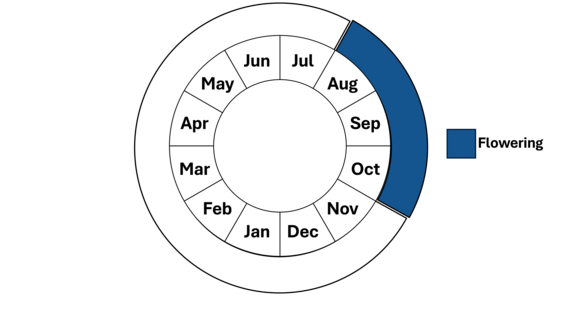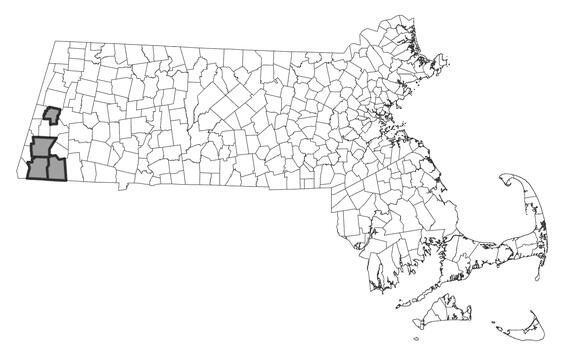- Scientific name: Sporobolus neglectus
- Species of Greatest Conservation Need (MA State Wildlife Action Plan)
- Endangered (MA Endangered Species Act)
Description
Small dropseed is a slender annual of the grass family (Poaceae). Plants grow in small tufts with thin wiry ascending culms, or reproductive stems. The thin leaf blades are flat to loosely in-rolled. The lower leaf blades are longer than the uppermost blades, which become progressively shorter toward the top of the culm. The leaves may be smooth to slightly rough on the upper surface. The sheath, or tubular portion of the leaf that wraps the stem toward the base, has several long wispy hairs along its margins and at the junction with the blade. A short ligule, or membrane, is found on the leaf blade where it meets the sheath. The flower panicles are narrow, cylindric, and partially enclosed by the leaf sheaths. The terminal flower panicle is often smaller than the axillary panicles and purple-tinged. The flower panicle and upper leaves often become whitish or light cream in color upon senescing. Each tiny, egg-shaped spikelet, or flowering branchlet, is short-stalked, upright, and contains one flower. Upon maturing, the small, round, laterally flattened, brown to orange-brown grain falls from the spikelet. Small dropseed is a cleistogamous annual. Flowers may self-fertilize within that portion of the panicle enclosed in the leaf sheath. The small seeds produced in this way are quite hardy and remain viable in the seed bank for long periods of time. Small dropseed gets its name from the Greek spora, meaning seed and ballein, to cast forth, referring to the readily dropping small grains. The specific epithet, neglectus, is Latin for overlooked, in reference to the difficulty in observing this delicate low annual, which grows in late summer.
The culms of small dropseed reach 1-4.5 dm high (~0.33-1.5 ft). Leaf blades are 0.6-2 mm (0.02-0.08 in) wide and 1-12 cm (<1-4.7 in) long. Flower panicles are 2-5 cm (0.8-2 in) long and 0.2-0.5 cm (0.08-0.2 in) wide. Spikelets are 1.6-3 mm (0.06-0.12 in) long.
At the base of each spikelet are two small scales or bracts called the first and second glumes, which are subequal, 1.5-2.7 mm (0.06-0.11 in) long, lanceolate to ovate in shape, and smooth with a light green midvein. The glumes surround a floret, which consists of an outer scale (lemma), an inner scale (palea), and a flower with three very small anthers. The lemma and palea of small dropseed are smooth, thin to transparent, ovate, and roughly equal in length, 1.6-2.9 mm (0.06-0.11 in) long.
The lustrous light brown grain is 1.2-1.8 mm (0.05-0.07 in) long and covered by a thin membrane that is easily removed.
Small dropseed begins flowering in August and continues into October. Fruits start maturing in late September and continue until the first killing frost. The species becomes more conspicuous in late September through early November when surrounding taller vegetation starts to senesce.
Small dropseed is similar in appearance to wood poverty-grass (Sporobolus vaginiflorus), a more common species in Massachusetts. Small dropseed differs in having proportionally shorter culms, smaller and wider spikelets, smooth lemmas, and smaller grains. The following table highlights features differentiating the two species. The lustrous light brown grain is 1.2-1.8 mm (0.05-0.07 in) long and covered by a thin membrane that is easily removed.
Life cycle and behavior
This is an annual species.

Population status
Small dropseed is listed under the Massachusetts Endangered Species Act as endangered. All listed species are legally protected from killing, collection, possession, or sale, and from activities that would destroy habitat and thus directly or indirectly cause mortality and disrupt critical behaviors. MassWildlife’s Natural Heritage & Endangered Species Program database has 8 records from 1 county (Berkshire). Four of those records are within the last 25-year period. It is important to note that small dropseed has been reported very infrequently as a wayside plant east of Berkshire County; however, these sporadic or transient records do not represent indigenous populations.
Distribution and abundance
Small dropseed is known from Quebec west to Saskatchewan, Montana, Wyoming, Colorado, and New Mexico; south from New Hampshire and Vermont to Virginia, Tennessee, Arkansas, and Louisiana; and disjunct to Alabama, Washington, and California. It is considered a regionally rare plant by the New England Plant Conservation Program.

Distribution in Massachusetts. 1999-2024. Based on records in the Natural Heritage Database.
Habitat
Small dropseed is native to calcareous seeps, flat rocks, riverside outcrops, and river shores. It is also found occasionally along roadsides and other disturbed open sites. It is shade-intolerant and requires bare soil for germination. It is found in a wide range of soil moisture conditions from seepy to dry. It is able to survive harsh environments and periods of severe drought by seed banking until conditions are conducive for germination. Typical plants found scattered in openings with small dropseed are Kalm’s lobelia (Lobelia kalmii), grass of parnassus (Parnassia glauca), three-lobed violet (Viola palmata var. dilatata), golden sedge (Carex aurea), little bluestem (Schizachyrium scoparium), and shrubby cinquefoil (Dasiphora floribunda). Many sites show evidence of natural or anthropogenic disturbances such as river scour, seepage gullies, mechanical scraping, and right-of-way maintenance.
Healthy habitats are vital for supporting native wildlife and plants. Explore habitats and learn about conservation and restoration in Massachusetts.
Threats
Disruption of natural flood regimes and sedimentation patterns along rivers, interruption of hydrologic flow in seepage banks, soil stabilization projects, and lack of small-scale disturbance may limit the ability of small dropseed to find bare soils to germinate and grow. Small dropseed is quite intolerant of shade and competition from other plants, including native species such as shrubby cinquefoil and nonnative invasives such as asiatic bittersweet (Celastrus orbiculatus).
Conservation
Suitable habitats should be inventoried for additional undocumented populations of small dropseed. Plant occurrences should be monitored to gain a better understanding of population dynamics, land use history, and threats. Small dropseed habitat should be monitored for competition and over-shading by aggressive native and exotic invasive plants.
Preserving the natural hydrologic regime will ensure sustained quality habitat for this rare plant. Maintenance of bare soil areas within early successional habitats is critical to ensure seed germination and continued viability of small dropseed. Certain occurrences may benefit from well-timed prescribed management activities, such as cutting, mowing, soil scarification, or burning in early successional habitats, to reduce plant encroachment and provide a mineral seedbed for germination of small dropseed. All active management within the habitat of a rare plant population (including invasive species removal) is subject to review under the Massachusetts Endangered Species Act and should be planned in close consultation with the Natural Heritage and Endangered Species Program.
References
Fernald, M.L. 1950. Gray’s Manual of Botany, ed. 8. New York.
Gleason, H.A., and A. Cronquist. 1991. Manual of Vascular Plants of Northeastern United States and Adjacent Canada, ed. 2. Bronx, New York.
McGregor, R.L. 1990. Seed Dormancy and Germination in the Annual Cleistogamous Species of Sporobolus (Poaceae), Kansas Academy of Science 93(1-2). pp8-11.
Peterson, P.M., S.L. Hatch, and A.S. Weakley. 2003. Flora of North America, Vol.25. Sporobolus, modified by Barkworth from Barkworth et al. (eds.) Viewed at http://herbarium.usu.edu/treatments/Sporobolus.htm webmanual 26 April 2010.
Weatherbee, P.B. 1996. Flora of Berkshire County, Massachusetts. The Berkshire Museum, Massachusetts, USA.
Contact
| Date published: | May 8, 2025 |
|---|